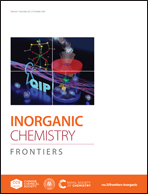Exploiting the labile site in dinuclear [Pd2L2]n+ metallo-cycles: multi-step control over binding affinity without alteration of core host structure†
Abstract
While Nature often controls supramolecular processes through regulation giving multiple levels of activity, synthetic metallosupramolecular systems have generally been binary (e.g. on/off) when they have control over molecular recognition events, and have often relied upon drastic chemical transformations or complete disassembly to enforce this control. We report here a new low symmetry ligand with a bidentate and a monodentate site (L). In combination with Pd2+, this ligand forms a [2 + 2] metallo-macrocycle, [Pd2L2L′2]n+, where L′ is the monodentate ancillary ligand that occupies the fourth and final coordination site of the metal ions. This assembly is structurally simple, but displays nuanced, multi-step binding affinity toward a neutral diplatinate guest employed for proof-of-concept. This complexity is introduced through varying the identity of L′, which can either be solvent (DMSO) or the halides chloride, bromide or iodide. The identity of L′ alters the cationic charge of the complex (neutral DMSO versus monoanionic halides) or otherwise influences the electron deficiency of the binding site of the host through varied strength of halide-ligand intra-molecular hydrogen bonding. Cycling between these different complexes was demonstrated, except for L′ = chloride which is non-reversible. This system therefore is able to interact with a platinate guest with four different graduations of affinity in response to stimuli, while still retaining the same simple core cationic structure. In addition to multi-setting binding affinity, we believe this is the first example of the use of variable intramolecular hydrogen bonding strength in switchable ancillary ligands to alter the electronic character and hence the π–π recognition characteristics of a metallosupramolecular host.
![Graphical abstract: Exploiting the labile site in dinuclear [Pd2L2]n+ metallo-cycles: multi-step control over binding affinity without alteration of core host structure](/en/Image/Get?imageInfo.ImageType=GA&imageInfo.ImageIdentifier.ManuscriptID=D0QI00901F&imageInfo.ImageIdentifier.Year=2020)


 Please wait while we load your content...
Please wait while we load your content...